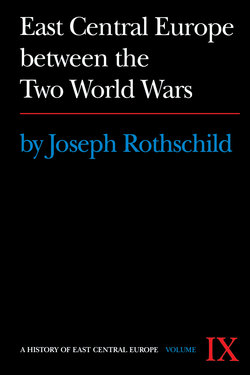Читать книгу East Central Europe between the Two World Wars - Joseph Rothschild - Страница 10
На сайте Литреса книга снята с продажи.
ОглавлениеPREFACE
THE study of East Central Europe between the two world wars is not only intrinsically important for the historical record but is also currently relevant to America’s national concern and interest. The relaxation in the techniques of Soviet control over the East Central European area, and the partial withering of the substance of that control in and over a number of the area’s states, elicit and, in turn, are accelerated by the revival of certain political patterns that had been suppressed during the 1940s and 1950s. The experiences and memories of the interwar period of political independence have reasserted themselves and are helping to shape the current and future expectations of these countries’ societies and elites. Hence a policy of building bridges to these countries requires an awareness of their interwar histories.
Furthermore, both individually and collectively, the several states of interwar East Central Europe present a good body of historical experience for the comparative study of the political and socioeconomic problems that confront developing multiethnic societies in general. Though the strategies adopted for the attempted resolution of these problems by the local East Central European elites at the time proved unsuccessful (quite apart from the fatal intervention of World War II), an analysis of the problems and the strategies as such should have value for scholars, students, and, perhaps, rulers concerned with understanding and mastering similar issues in other societies.
Though I have attempted a comprehensive study of interwar East Central Europe, I have deliberately avoided symmetry in my analyses of its several countries. Certain problems characteristic of the entire area, or much of it, are discussed in detail for only one or two countries, and only synopses of these issues are given in the chapters on other countries. For example, my extended probe of the Romanian Iron Guard is intended to serve paradigmatically for such Right-Radical movements in general. Parallel phenomena in other countries, e.g., the Hungarian Arrow Cross and the Croatian Ustasa, are mentioned as political factors where appropriate, but I do not analyze them for their ideological, sociological, or psychological significance. Similarly, Bulgaria functions as my paradigm for the economics of peasant agriculture, Hungary for the impact of the depression on a transitional economy, Czechoslovakia and Yugoslavia for political problems arising from multiethnicity, and Poland for the structure and program of a “government party.” Again, the Jewish question is studied in some detail only in Hungary, Poland, and Romania, which are exemplars, respectively, of heavily assimilated, unassimilated, and mixed Jewish communities; it is only given passing mention elsewhere. Had I attempted to plumb such issues to equal depths for each country, the book would have become repetitious and its size would have exceeded its editorial perimeters. Since it is intended to be read as a whole, the reader will have no difficulty in applying the case studies to related phenomena in other countries.
An additional caveat appears in order here: there are no separate chapters for Austria or Greece, though they are discussed whenever necessary. Great as had been Habsburg Austria’s pre-World War I position in East Central Europe, the small interwar Austrian Republic was not politically or economically or spiritually a part of the area. Her domestic and foreign attention was absorbed by the problematics of Anschluss—whether to initiate, resist, or accommodate to it—and her involvement with East Central Europe was quite secondary. Greece, in turn, though diplomatically engaged in Balkan issues, regarded herself as a Mediterranean, not an East Central European, country in terms of cultural, economic, and political perspectives. For each of the countries to whom I have devoted separate chapters, the narrative is carried through the moment of its loss of effective territorial sovereignty during or on the eve of World War II: 1939 for Czechoslovakia, Albania, and Poland; 1940 for the three Baltic states of Estonia, Latvia, and Lithuania; 1941 tor Yugoslavia; and 1944 for Hungary, Romania, and Bulgaria.
The decision to keep footnotes to a minimum was the editors’ and publisher’s. Any reader desiring source references for factual statements made in this book is welcome to write to me directly. Three former students, Andrew Dzirkalis, Benjamin Lopata, and Jonathan Sunshine, are cordially thanked for their conscientious bibliographical assistance. I also wish to express my warm appreciation to the John Simon Guggenheim Memorial Foundation, the American Council of Learned Societies (Joint Committee on Slavic and East European Studies of ACLS and SSRC), and the Columbia University Institute on East Central Europe for their financial generosity.
After my manuscript was delivered to the editors came the dismaying news of the premature death of my teacher, colleague, and friend Henry L. Roberts. Professor Roberts first drew me to the study of East Central Europe as an undergraduate in Columbia College and thereafter sustained this interest by his encouragement and example. He was a scholar of wide erudition, subtle judgment, and absolute integrity. My debt to his intellect is immeasurable, my affection for his person abiding.
The American equivalents to the metric measures used in this book and in interwar East Central Europe are:
1 kilometer (km.) = 0.62 mile
1 square kilometer = 0.386 square mile
1 hectare (ha.) = 2.47 acre
1 cadastral yoke = 0.575 hectare = 1.42 acre
JOSEPH ROTHSCHILD
Columbia University
New York City
